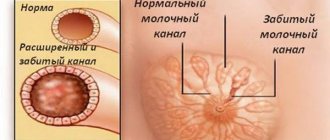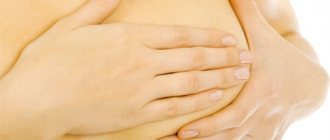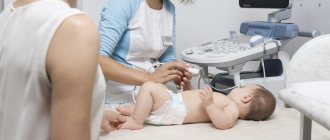Gynecomastia in adolescents
If, as a disease, gynecomastia may not worry either the patient or his parents, in the hope that everything will go away by itself after puberty, then the boy may be worried about its social aspect. It is quite difficult for a schoolchild to hide his breasts from his peers, and if they do not look like what others have, but are more reminiscent of a woman’s, then psychological trauma, loneliness, etc. may develop.
Everyone experiences the onset of puberty differently, it can start at 8 years old, 15 years old and continue until 18 years old and even 19 years old. Therefore, it is extremely important for parents to pay attention to the physical and psychological state of their child. It is important that his life includes physical activity, a balanced diet, enough vitamins and minerals, and no stress.
The disease code according to ICD 10 in children is No. 62. Juvenile gynecomastia can be either unilateral or bilateral - in any case, it is necessary to determine the cause and prescribe treatment.
Why does newborn mastitis develop?
If, during the development of physiological mastopathy, an infection enters the child’s body (usually staphylococcal or streptococcal), there is a risk of newborn mastitis: moreover, it can occur in both newborn girls and newborn boys. Staphylococcal or streptococcal bacteria can live in the mother's body (for example, on the surface of her skin or on the mucous membrane of the nasopharynx), and can also be found on surfaces in toilets and bathrooms.
Most often, mastitis in a newborn develops after discharge from the hospital - approximately on the 10th day of the baby’s life. By this time, the baby’s mammary glands should return to normal. And if the mother sees that this did not happen, it is necessary to urgently consult a pediatrician.
Microorganisms enter the body under certain conditions, usually when parents do not properly care for the child, not taking into account the special properties of his skin:
- it has a lot of microvessels;
- it has high permeability, so any substances from its surface immediately enter the body and the bloodstream;
- the fatty tissue under the skin is very thick and loose;
- sweat and sebaceous glands cannot yet function normally and create antibacterial protection; and if maternal immunity was unable to protect the child from bacteria (after all, the baby’s skin does not immediately accept all its microorganisms from the mother - the process of this colonization occurs gradually), they immediately cause an infectious pathology in the body;
- the thermoregulation process has not yet been adjusted;
- the skin is very saturated with liquid.
- How and why can an infection occur?
- if the child is dressed without taking into account the air temperature, and diaper rash occurs on his skin;
- if the baby’s clothes have rough seams or edges that injure delicate skin;
- if, while treating the child’s skin, the mother accidentally scratches or damages the skin (for example, with a manicure).
Main reasons
Let's look at the main reasons that lead to breast enlargement in boys:
- the beginning of the production of male sex hormones, especially testosterone. In a young body, all the mechanisms of work have not yet been adjusted, especially the work of the entire reproductive system. When testosterone is formed, it goes through a stage in which it becomes very similar to estrogen, and estrogen is a female sex hormone, which also affects the growth of mammary glands in girls. So, if the hormonal system is normal, then testosterone goes through all stages and works it’s normal, if a malfunction occurs, then there is little testosterone and a lot of estrogen, as a result - breast growth in a teenager;
- excess weight in a child - contributes to the development of false teenage gynecomastia, can be both a complicating factor for gynecomastia and provoke its development due to a detrimental effect on the hormonal system;
- the presence of pathologies in which the production of estrogen significantly increases. Such diseases include chromosomal abnormalities, liver dysfunction, neoplasms in the genital organs;
- extremely rarely, gynecomastia in boys is caused by injuries and damage to the chest area;
- various genetic anomalies - Reifenstein syndrome, Kallmann syndrome, XX-men, etc.;
- taking certain medications. There is a high probability of enlargement of the mammary glands in adolescents when taking anabolic steroids and other drugs that can make adjustments to hormonal levels.
All causes can be simultaneously or interconnected, so it is necessary to conduct a thorough diagnosis, since the success of treatment will depend on the identified cause.
Swelling of the mammary glands in infants: what to do?
Swelling of the mammary glands in infants: what to do?
Young parents, when any problem arises with their newborn baby, immediately begin to panic. It’s so scary when a baby has something in pain or gets sick. What to do if the mammary glands of an infant are swollen? Ask yourself these questions:
- Is only one mammary gland swollen or two at once?
- Have other alarming symptoms appeared (tearfulness, fever, lumps in the glands)?
- Is the newborn less than a month old?
- Do you have white pimples on your face?
Swelling of the mammary glands in infants and white pimples on the face
Assess the situation. If your child has a fever, lethargy, severe swelling of the mammary glands, and even a lump is palpable, contact your pediatrician. The doctor may recommend that the parents undergo hospital treatment.
What is the fine line between physiological norm and pathology:
- If there are small cracks on the nipples , then after 2-3 days they can develop into full-fledged mastitis with complications. Treatment in this case should be immediate.
- If, 7-8 days after the first symptoms of a hormonal crisis appear , the symptoms have not disappeared, and the baby’s condition worsens - the glands turn red and continue to swell, the discharge is abundant or even purulent, you should immediately consult a pediatrician.
- There is a general malaise, the skin on the face is very hyperemic, the body temperature is elevated - all this indicates an inflammatory process. It will not disappear on its own and requires the intervention of specialists.
Symptoms of pubertal gynecomastia in boys
Signs of abnormal development are quite easy to suspect, since they are of a pronounced nature, for example:
- a boy may experience significant enlargement of one or both breasts;
- you can notice that the area of the nipples has increased, and their swelling is often observed;
- when palpating, there may be lumps under the nipple halo;
- a teenager may experience itching and even pain in the chest area;
- Discharge from the nipples is extremely rare.
If you suspect any violations in adolescents, you must immediately consult a doctor to conduct a diagnosis and identify the main cause that led to these violations.
A newborn girl and boy have swollen, enlarged mammary glands: reasons, is it dangerous?
A newborn girl and boy have swollen, enlarged mammary glands: reasons, is it dangerous?
In the womb, the child receives a huge dosage of hormones. After birth, the baby is deprived of a source of various substances and begins its life. Therefore, his level of biological components drops sharply, which leads to the appearance of unwanted symptoms. All these are the causes of swelling of the mammary glands, which can be observed in both girls and boys.
Is it dangerous that a newborn girl or boy has swollen, enlarged mammary glands? Let's look at everything in order:
- Many experts are inclined to believe that swelling of the mammary glands in a newborn baby or the appearance of slight swelling is a normal physiological process. It needs to be monitored, but no treatment is required.
- On the 6-7th day of life, the baby’s thin and delicate skin around the nipples may turn red and swell. It is also considered normal that along with the swelling, a little colostrum appears, released from the nipples.
- Hormonal crisis occurs in 70% of newborns. It is believed that this condition occurs in well-developed children - large in weight and in good health. These babies usually have a high Apgar score.
- However, this condition should not be ignored. The glands can not only swell. They become inflamed and a process of suppuration appears. In addition to this symptom, slight discharge from the genital organs is observed, which also leads to the appearance of infection, but in this organ. Hormonal traces also appear on the face in the form of a rash with white pimples. They disappear later than all other symptoms and can also fester.
A newborn girl and boy have swollen, enlarged mammary glands: reasons.
What parents should do if their child experiences similar problems:
- Watch the baby. If not only the mammary glands, but also the genitals are swollen, consult a pediatrician.
- It is necessary to consult a doctor if your baby has a fever above 38 degrees.
- If pimples appear on the face, they should not be squeezed out, just as it is unacceptable to squeeze colostrum out of the nipples. This can lead to infection and complications.
- Follow the rules of hygiene before approaching a newborn : wash your hands thoroughly, especially after visiting the toilet or going outside, bathe the child every day, wash regularly, do not allow people who have a sore throat, acute respiratory viral infections or those with purulent wounds on the body to approach the baby.
Important to know: Usually the hormonal crisis passes on the 6-18th day of the baby’s life. If this period drags on or complications appear in the form of fever and suppuration, immediately consult a pediatrician.
Diagnosis of gynecomastia in children and adolescents
If you suspect a hormonal imbalance or the development of gynecomastia, you should contact an endocrinologist. When contacting a doctor, they will perform palpation and a full examination of the patient. Based on these data and the collected medical history, the specialist will be able to make a preliminary diagnosis, and to clarify the degree of development of juvenile gynecomastia, identify complications and the causes of its occurrence, the patient will be sent for an ultrasound and blood test.
Based on the diagnosis, the doctor can name the cause of the boy’s condition: genetic predispositions, serious hormonal disorders, or simply an imbalance of the hormonal system, which is caused by adolescence.
By identifying the cause of the development of teenage gynecomastia and assessing the general condition of the patient, the specialist will be able to tell how to treat the disease.
Mastitis in children
Injury to the baby's skin or infection in the mammary glands at different ages leads to a complication - mastitis (an infectious-inflammatory process). The baby has an unstable immune system, which is difficult to overcome a purulent infection, so you need to know the symptoms and causes of the disease.
Symptoms
Signs of mastitis in infants:
- Fever
- Intoxication, manifested by weakness, drowsiness, loss of appetite
- Constant crying
- Uneven increase in the size of the mammary glands
- Palpable seals
- Enlarged lymph nodes of the armpits
- Nausea and vomiting
- Pain on contact with the chest
- Redness of the skin around the areola
Symptoms vary depending on the stage of development of mastitis.
Serous mastitis (without pus). The initial stage of the disease is characterized by the manifestation of minimal signs of impairment. The child's behavior changes, he becomes capricious, lethargic, with a slight increase in temperature. Infiltrative mastitis. There is an obvious inflammatory process. The area of the nipple, areola, and mammary glands changes: turns red, swells, swells
The baby has a fever and feels unwell. At this stage, pus accumulates in the capsular cavity. Purulent mastitis
Inflammation turns into phlegmon. The contents of the abscess rupture the capsule and penetrate into the glandular tissue. The condition is accompanied by fever. This form poses a danger to the child's life.
Causes
Inflammation of the mammary glands in a newborn develops due to infection (usually staphylococcus, streptococcus) in the thoracic region.
The prerequisites for inflammation are:
- Microcracks on the nipples
- Poor baby hygiene
- Wearing rough clothes
- Breast injuries
- Diaper rash and wet wounds
The development of mastitis often occurs during physiological swelling of the mammary glands in children.
Treatment of mastitis in children
Any stage of the disease requires treatment.
For serous mastitis (without pus), conservative therapy is prescribed. The task of parents is to properly care for the child, treatment, eliminate mechanical stress on the breast and fully comply with the doctor’s instructions
It is important not to self-medicate
The purulent form of mastitis is treated surgically. A drain is inserted into the incision, through which the pus is pumped out. Then bandages are applied. After surgery, it is recommended to carry out physical therapy, take antibacterial drugs and vitamins.
Girls (unlike boys) are at greater risk of complications from mastitis when they become adults. Among them are inflammatory processes of the breast, blockage of the milk passages, mastopathy, and oncological formations.
Treatment methods for pubertal gynecomastia
After undergoing diagnostic tests and confirming the diagnosis, the endocrinologist will prescribe treatment based on the data obtained.
In most cases, serious treatment of the patient, especially surgery, is not required and when the hormonal system is stabilized, all indicators return to normal. But, if enlargement of the mammary glands in boys continues for a long period of time, then drug treatment or surgery is necessary.
Depending on the root cause of the problem, medications are prescribed. Most often, a teenager must take pills containing male sex hormones, or medications that suppress the secretion of estrogen.
For normal growth and development of the body during puberty, a child needs a sufficient amount of vitamins and minerals. They can be obtained either from food or in the form of special dietary supplements.
During the treatment of teenage gynecomastia, it is mandatory to take vitamin-mineral complexes, or a specialist may prescribe the intake of some individual elements that are in short supply in the patient’s body.
Which doctor should I contact?
I, Romanov Georgy Nikitich, endocrinologist, candidate of medical sciences. For more than two decades I have been helping people with various diseases. I gained my experience not only in our country, but also abroad, both in Russia and in some Western countries. I know modern methods of treating and diagnosing patients with endocrine diseases. For 3 years of work, I had more than one patient with pubertal gynecomastia, which we successfully treated.
Today I work in a clinic and also provide paid online consultations. To get an appointment with me, you need to make an appointment in one of the proposed messengers: Viber, Telegram, Instagram, WhatsApp, Skype, Vkontakte.
I will be glad to see you among my patients.
Sexual crisis - what is it?
Symptoms of a gentle crisis in recently born children are manifested not only by swelling of the glands located on the chest, there may even be swelling of the external genital organs, milia (white spots) on the face, fluid leakage from the genital tract (girls have both white and bloody discharge ). Sexual crisis occurs in 75% of newborns, including boys.
Basically, symptoms of a sexual crisis accompany absolutely healthy children; doctors think that this is a sign of the child’s uncomplicated reaction to outdoor life. Premature and low birth weight newborns with sexual crisis are quite rare.
Swelling of the mammary glands is an individual physiological process.
Swelling of the mammary glands in newborns is called physiological mastopathy. It is noticed by a change in the size and density of the baby's breasts. Most often, engorgement of two mammary glands is noticed, and very rarely it appears on one side.
This does not cause any problems for the baby, so it is not recommended to take any specialized actions. Often, swelling of the mammary glands accompanies the baby from the first week of his life, and at the end of the first month of life the swelling goes away on its own.
It is important to know! The most normal enlargement of the mammary glands is up to 3 cm in diameter. And the epidermis should not have any changes or redness... Treatment of breast engorgement:
Treatment of breast engorgement:
Most parents are trying to cope with any changes in their babies’ bodies. You should not treat breast engorgement on your own. Some parents begin to feel the bruised area in hopes of seeing if it will help reduce swollen breasts. But all you will achieve by doing this will be irritation of your baby’s mammary glands.
Since this is not a serious problem, give the baby some time. By the fifth week of life, your baby's breasts will begin to contract naturally.
Don't massage the swollen area too often. Excessive breast massage or pinching can lead to infection. Therefore, all you have to do is simply give your baby a bath.
It is not recommended to make any compresses or use ointments.
Breast-feeding.
Breastfeeding can contribute to the baby's breast swelling due to the continued transfer of hormones to the mother through milk. That is, breastfeeding may also promote long-term breast enlargement and milk production (witches milk) in the infant, but weaning is not recommended.
conclusions
Thus, most often gynecomastia in adolescents occurs due to immature hormonal levels, is not pronounced and goes away on its own. Only in a small number of cases is it dangerous and can develop into serious violations. But do not forget that a disease left to chance can worsen and, instead of a favorable outcome, become even more serious and dangerous, so any deviations in the functioning of the body must be monitored by a specialist.
Diagnosis of the disease
Diagnosis of the disease is based on the characteristic symptoms of the disease and the deterioration of the baby’s well-being.
At the first signs of mastitis in a baby, parents should immediately contact a specialist. A qualified physician determines the presence of mastitis immediately by visual examination, noting:
- Increase in breast size.
- The chest feels hot to the touch.
- Feeling of fluctuation or unevenness of gland tissue due to purulent accumulation.
- Crying of a child when palpating the breast due to its soreness.
To identify the specific pathogenic causative agent of the disease, doctors insist on culture of nipple secretions. Simultaneously with bacterial culture, the sensitivity of the pathogenic organism to antibiotics is determined.
Regarding hardware examination methods, in most situations there is no need to use them if mastitis has a characteristic symptomatic picture, but in order to clarify the diagnosis, an ultrasound scan can be prescribed.
First of all, the differential diagnosis of mastitis is compared with the following diseases:
- Physiological type mastopathy.
- Erysipelas inflammation of the skin.
- A consultation with a surgeon may also be required.
Additional methods for diagnosing inflammatory pathology are not used, as they can be difficult for such small patients, so if the baby was absolutely healthy before mastitis, then the study is limited to generally accepted laboratory tests.











